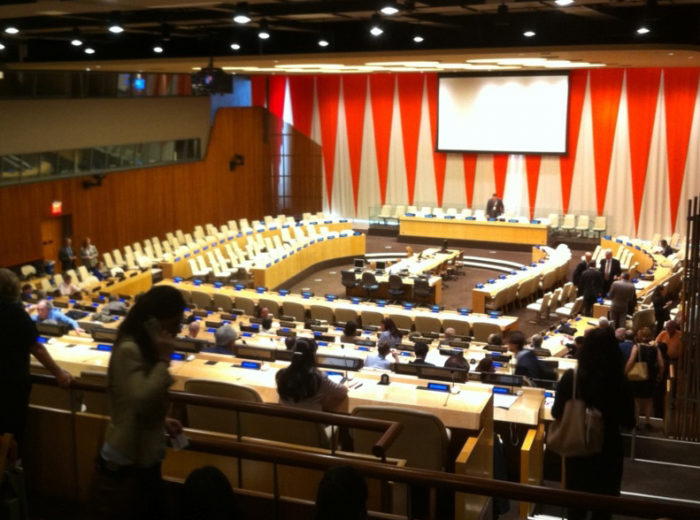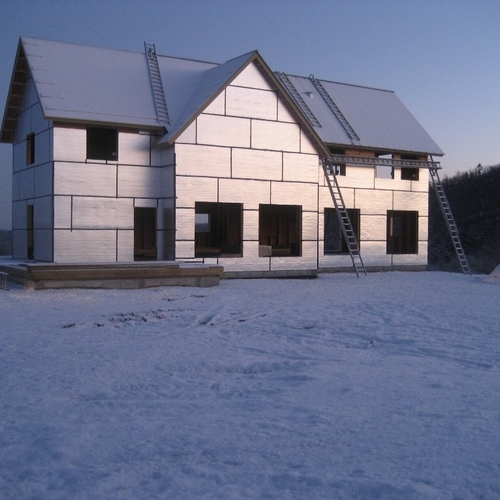Image Credit: Alex Wilson
Image Credit: Alex Wilson Harni Nagendra, a Ramanujan Fellow at the Ashoka Trust for Research in Ecology and the Environment in Bangalore, India, spoke on biodiversity in densely developed cities. That's me on the left side of the podium...intimidated!
Image Credit: Wendy Brawer A reception following the conference looking out across the East River from a fourth-floor deck at the UN.
Wrapping up an intense month of travel, I’m just back from New York City, where I spoke last Friday at the UN World Habitat Day conference, “Resilient Design for Sustainable Urbanism.” The event was cosponsored by the Consortium for Sustainable Urbanism, AIA New York, and the NJIT Center for Resilient Design.
It was an amazing opportunity to see the United Nations; I think I was last there over 40 years ago. The UN Headquarters Complex is going through a major $2 billion facelift that includes many exciting green features that are supposed to achieve 50% energy savings, 40% water savings, and a 45% reduction in the carbon footprint… But that’s not the focus of this column.
UN-Habitat addresses resilience
The United Nations Human Settlements Programme, or UN-Habitat, is a UN agency focused on human settlements. It was launched in 1978 following a meeting in Vancouver known as Habitat I, and it is mandated by the UN General Assembly to promote socially and environmentally sustainable towns and cities with the goal of providing adequate shelter for all. A follow-up conference, Habitat II, was held in Istanbul, Turkey in 1996, and Habitat III is planned for 2016.
The conference last week was one of a number of events leading up to Habitat 3, and it reflected a growing interest by the UN in climate change, rising sea levels, and the impact these changes will have on urbanization.
Ban Ki Moon opens the event
The day started off with an all-star cast. UN General Secretary Ban Ki Moon from South Korea opened up the program and described the UN’s deeply held concerns about climate change and commitment to both sustainability and resilience. Ban Ki Moon was followed by John Ashe of Antigua and Barbuda, president of the UN General Assembly; Néstor Osorio, the Colombian Representative to the UN and president of the UN Economic and Social Council; and Dr. Joan Clos of Spain, the Executive Director of UN-Habitat.
Shaun Donovan, the Secretary of HUD in the U.S. and chair of the federal Hurricane Sandy Rebuilding Task Force, was supposed to deliver the keynote address, but could not due to the federal government shutdown. (How embarrassing to see such a poignant display of American dysfunction on the international stage!) In his place was Henk Ovink, the former director general for Spatial Planning and Water Affairs for the Netherlands — and currently on loan to the U.S. for the above-mentioned task force.
Morning and afternoon panels dug more deeply into various aspects of resilient design. In the morning panel I described how our vulnerabilities extend well beyond sea level rise and coastal flooding to such issues as more intense storms, inland flooding of valleys (as we saw with tropical storm Irene here in Vermont), tornadoes, ice and snow storms, drought, wildfire, solar flares, and such anthropogenic issues as terrorism and political upheaval. I described a number of secondary impacts of these events, including prolonged power outages, interruptions in gasoline supply, or an inability to pump gasoline. Finally, I presented the Resilient Design Principles that have recently been published by the Resilient Design Institute.
Solutions are elusive
While all of us on the podium did a reasonable job articulating the challenges we face from sea level rise and climate change, effective solutions remain elusive.
Some solutions were offered, surprisingly, by Dawn Zimmer, the mayor of Hoboken, New Jersey, just across the Hudson River from Manhattan. I say “surprisingly,” because I remember the photo of perhaps 100 taxis submerged by Sandy’s storm surge. I had been under the impression that Hoboken was far less prepared for flooding than New York, where Mayor Bloomberg has been at the forefront of disaster preparedness. But she told us of some amazing planning underway in the city, such as efforts to provide for safe bicycle commuting through the Lincoln Tunnel and other strategies to get cars off the streets.
Henk Ovink noted that simply building things back to what they had been in the aftermath of storms like Sandy or Katrina is a lost opportunity. We need to learn from these disasters and respond appropriately. “Let the past be an inspiration for the future,” he told us in the afternoon.
One of the most inspiring presentations was by Nancy Kete, the managing director of the Rockefeller Foundation, which just announced a $100 million program to support 100 cities around the world in developing and implementing plans for urban resilience over the next three years. The foundation will provide technical support and financial resources in this remarkable program.
The full presentations from the conference are available online on the NJIT Center for Resilient Design website in three video segments.
Sea level is rising and storms are becoming more intense
There is much to do in addressing the multiple challenges of rising seas, more intense storms, and other impacts of climate change. But the UN’s leadership with climate change, not only with science (see the just released 5th Assessment Report from the International Panel on Climate Change) but also initiatives to do something about these challenges, gives me hope that progress can be made.
Sequestered in the U.S., where Fox News does a highly successful job at foisting its fringe perspectives on politicians and a significant portion of the public, one can lose sight of just how seriously most of the rest of the world is taking climate change.
Alex is founder of BuildingGreen, Inc. and executive editor of Environmental Building News. In 2012 he founded the Resilient Design Institute. To keep up with Alex’s latest articles and musings, you can sign up for his Twitter feed.
Weekly Newsletter
Get building science and energy efficiency advice, plus special offers, in your inbox.
















One Comment
Resilient design is easy
The planet has one basic problem for humans. Population verses resources verses knowledge breakthroughs to deal with the aforementioned.
All this blog is about is you doing something for income. Your time and effort serves your needs but does nothing to deal with what is basic and stated above by me IMHO.
Do you consider your efforts large and your ego small... Or vise versa.... Or not at all?
Log in or create an account to post a comment.
Sign up Log in